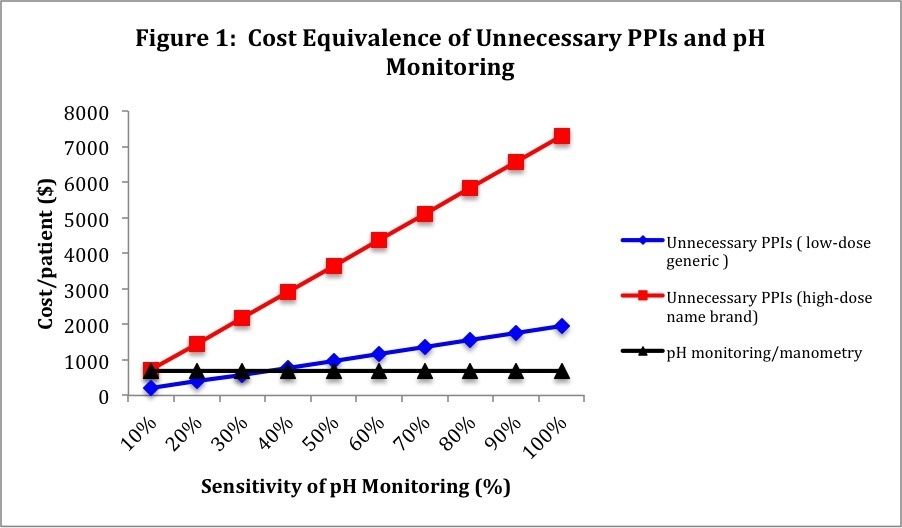
|
 |
Back to Annual Meeting Program
Early Referral for 24-Hour Esophageal pH Monitoring Is More Cost-Effective Than Prolonged Use of Proton Pump Inhibitors in Patients With Suspected Gastroesophageal Reflux Disease
David Kleiman*1, Toni Beninato1, Brian P. Bosworth2, Laurent Brunaud4, Thomas Ciecierega3, Carl V. Crawford2, Brian G. Turner2, Thomas J. Fahey1, Rasa Zarnegar1
1Surgery, New York Presbyterian Hospital - Weill Cornell Medical College, New York, NY; 2Medicine, New York Presbyterian Hospital - Weill Cornell Medical College, New York, NY; 3Pediatrics, New York Presbyterian Hospital - Weill Cornell Medical College, New York, NY; 4Surgery, University Hospital Nancy, Brabois, France
BACKGROUND: Gastroesophageal reflux disease (GERD) affects nearly 25% of adults, but the diagnostic algorithm remains controversial. Most guidelines recommend an empiric 8-week trial of proton-pump inhibitors (PPIs), but many patients remain on PPIs for much longer periods. Twenty-four hour esophageal pH monitoring can help rule out GERD and avoid the unnecessary cost and risks of prolonged PPI use. We hypothesized that performing pH monitoring promptly after an 8-week PPI trial would be a more cost-effective strategy than prolonged courses of PPIs.
METHODS: A cost model was created from a third-party payer perspective over a 10-year period. Average wholesale unit prices of generic and name-brand PPIs were obtained from the 2012 Micromedex Redbook®. Low-dose (20 mg daily) generic PPI and high-dose (40 mg twice daily) name-brand PPI costs were used as the low-end and high-end PPI costs, respectively. The cost of 24-hour pH monitoring and manometry was obtained from 2012 Medicare fees. Manometry was necessary to determine esophageal function and for appropriate positioning of the pH probe. A cohort of 100 patients who underwent pH monitoring at an academic institution was retrospectively reviewed for type of GERD symptoms and duration of PPI use prior to pH monitoring. The sensitivity of 24-hour pH monitoring by literature review ranged from 30% to 96%. The cost of unnecessary PPIs was subtracted from the cost of pH monitoring for all patients to evaluate the cost-effectiveness.
RESULTS: The weekly cost of PPIs ranged from $29.06 to $107.70, and the cost of 24-hour pH monitoring was $690. The cost of PPI therapy reaches equivalence with pH monitoring after 6.4 to 23.7 weeks, depending on the PPI regimen. Patients who experienced esophageal and extra-esophageal GERD symptoms reported a median of 208 and 52 weeks of PPI use, respectively, prior to referral. The cohort was prescribed a total of 21,411 weeks of PPIs beyond the initial 8-week trial, 32% of which were for patients who had a negative 24-hour pH monitoring study and were therefore unnecessary. If the sensitivity of pH monitoring was 100%, performing pH monitoring on all patients after an 8-week PPI trial would have saved between $1,966 and $7,285 per patient over 10 years. This strategy remains cost-effective as long as the sensitivity of pH monitoring is above 35% (Figure 1). In this model, since patients with extra-esophageal GERD symptoms were referred a median of 156 weeks sooner than patients with esophageal symptoms, the cost savings were less (Table 1).
CONCLUSIONS: Most patients are maintained on PPIs for periods greatly surpassing the cost-equivalence point with 24-hour esophageal pH monitoring. Early referral for pH monitoring after a brief empiric PPI trial may result in substantial cost savings for patients with both esophageal and extra-esophageal GERD symptoms.
Table 1. Estimated range of cost savings over 10-yearts (per patient) of performing early 24-hour pH monitoring across the range of reported sensitivity for diagnosing GERD.
| 30% sensitivity (1) | 96% sensitivity (1) | | All patients | -$100.31 (2) to $1,495.45 | $1,196.99 to $6,303.43 | | Esophageal symptoms | -$59.57 (2) to $1,646.44 | $1,327.37 to $6,786.61 | | Extra-esophageal symptoms | -$299.23 (2) to $758.25 | $560.47 to $3,940.09 |
(1) Range of savings from low-dose generic PPI to high-dose name-brand PPI, (2) Negative values reflect additional cost over 10-years.

Back to Annual Meeting Program
|


